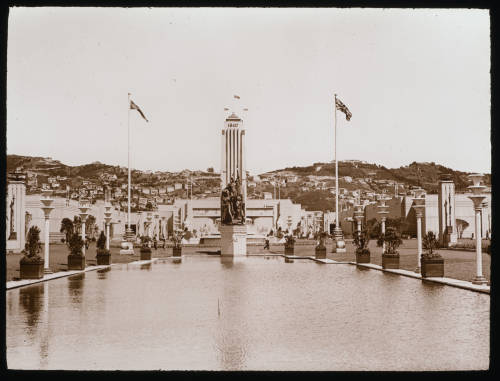The New Zealand Centennial Exhibition celebrated 100 years since the signing of the Treaty of Waitangi in 1840. It ran from November 1939 until May 1940 on a site at Rongotai next to the airfield. The architect Edmund Anscombe designed the buildings and grounds in the Art Deco style.
Edmund was born in 1874 in Sussex, England. His family emigrated the same year as part of the Assisted Immigrants scheme and they settled in Dunedin. He attended Caversham School and in 1888 he went to Melbourne to visit their 1888 Exhibition. He said:
“From then on, anything pertaining to Exhibitions held for me its own decided and never ending interest”.
He also attended the Chicago World Fair (1933) and New York’s World Fair (1939) among others.
His architectural work in Dunedin included the Lindo Ferguson Building, Arthur Barnett’s Department Store and the Logan Park Grandstand. In 1928 he moved to Wellington and notable among his buildings here is the Post & Telegraph building next to Waitangi Park. He was eating inside one of his own buildings in Hastings when the 1931 earthquake struck, and having such faith in his own work he continued eating and the building was one of the few to remain standing.
Construction on the Centennial Exhibition site began in April 1939 by Fletcher & Love Construction Companies and involved over 1000 people. The site was over 22 Hectares in size of which the buildings covered 7 Hectares.
The Exhibition was intended to show New Zealand’s progress and achievements. Inside the buildings were endless displays of modern technological wonders. There were ‘Courts’ or exhibition halls for Government Departments, Māori, Women, the Dominion, Engineering, Manufacturing, Transportation and the British Empire. There was even a model of the Waitomo caves.
But most visitors headed straight to the Crazy House with its tilting floors or the roller coaster in Playland, not visiting the ‘serious’ exhibits until a second or third visit.
The women’s section was made a special feature. There were displays of Victorian domestic interiors and in the Lecture Hall topics such as ‘The art of icing’; ‘What to do for burns’ and ‘Childrens’ fears’ were canvassed.
William Tretheway’s sculpture depicting Kupe, his wife Hine-te-aparangi, and a tohunga, on the waka Matahourua stood at the end of a reflecting pool facing the main entrance. It was hollowcast in plaster of Paris and painted bronze as it was only intended to last for the duration of the Exhibition. In 2000 it was recast in bronze and placed on Wellington’s waterfront.
After the Exhibition, the buildings were used in part by the New Zealand Air Force and then in 1946 what was remaining burnt to the ground.
Edmund died in 1948. His funeral service was held at St John’s Willis Street and he was cremated at Karori Cemetery. His ashes were interred in Anderson’s Bay Cemetery in Dunedin with his wife.
One of the first colour films in New Zealand was made by Edmund of the exhibition. It is only 30 seconds and well worth a look:
https://teara.govt.nz/en/video/43017/centennial-exhibition

